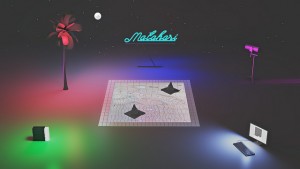Jeanne Charlotte Vogt – arts & technology, digital culture and performing arts
NODE17 Forum for Digital Arts „Designing Hope“
Who shapes our hopes today? What are the means used to translate
our fears and desires into images that incite feelings of hope?
What role does the design of technological infrastructures play?
Between collective hopes for a peaceful life in the Global Village on the one hand,
and feelings of powerlessness in the face of an ever more complex digitized world on the other,
NODE17 Designing Hope sets out to discuss the responsibility and potential of technology and design practices.
June 26 – July 02, 2017
Künstlerhaus Mousonturm & Naxoshalle, Frankfurt am Main
In its 5th edition, the biennial festival NODE Forum for Digital Arts reflected on the role of technology for the development and establishing of social atmospheres and imaginaries. Under the headline „Designing Hope“, NODE invited speakers and artists, theoreticians and practitioners, people from y 8-88 to contribute in an exhibition, a series of panels and a conference day, laboratories and think tanks. NODE17 hosted more than 50 workshops on creative coding and artistic technology applications in collaboration with vvvv.
Designing Hope
Hope fuels our actions to change the present and aspire for a better future. Hope bears transformative power and is in itself a creative and formative force. The hopeful mind does not give up but continues to invent solutions for problems it is faced with. It constantly imagines alternatives for the given, utopias that have the potential of becoming true. But this restless pursuit of the better is what makes hope a bittersweet pill, as it makes us endure the worst just for the sake of hoping that some day things might change, as long as we continue working and fighting for it. Hope is what’s left to humankind after Pandora opened her mythical box. The great evils escaped torturing us from then on – however, hope remained. The question raised is whether hope is the means to challenge all evils or, as German philosopher Nietzsche would put it, the greatest evil of them all? Either way: Hope is a mighty force.
This is what makes it so appealing to designers, politicians and advertisers. Hope can be used and abused by stirring up fears or amplifying confidence. The tools for this are the rhetorics of hope which manifest in images and imaginaries or in endless speeches peppered with the adequate keywords and delivered in the right tone. Technologies play a crucial part in this, as they are invented and used to maintain these rhetorics. At the same time they are also subject to our hopes. Although we don’t follow a modernist idea of technological progress leading to a brighter future anymore, we still engineer our world to tackle ecological, political and social deficits.
The exhibition “Designing Hope” gathers international artists who reflect on this ambiguity of hope and its making. Their works confront us with utopian and dystopian narrations, with investigations into the structures of designing hope, with ironic comments on simplistic promises and with promising eccentric hacks into our everyday life.
Exhibiting Artists
Adam Harvey, Alacoque Ntome, Amelia Marzec, Amelie Hinrichsen, Awuor Onyango, Benedikt Groß, Benjamin van Bebber, Bernd Hopfengärtner, Burak Arikan, César Escudero Andaluz, Eden Mitsenmacher, Else Tunemyr, Felix Kosok, Florian Egermann, Golan Levin, Heath Bunting, Jared Onyango, Jeremy Bailey, Joey Lee, Kathia von Roth, LAb[au], Lauren McCarthy, Leo Hofmann, Lilian Nejatpour, Ludwig Zeller, Martín Nadal, Marshmallow Laser Feast, Melisa Allela, Mika Satomi and Hannah Perner-Wilson (Kobakant), Milad Forouzandeh, Mohsen Hazrati, Neue Dringlichkeit, onformative, Pinar Yoldas, Shawn Sims, Simon Weckert, Tega Brain and many more…
The exhibition and the arts mediation program were funded by the Cultural Department of the City of Frankfurt am Main and the Stiftung Polytechnische Gesellschaft. The artistic and journalistic research project HOPE Lab and Digital Debate Lab were accompanying the program and were funded by experimente#digital / Aventis Foundation.
Curation: Jeanne Charlotte Vogt & Alexandra Waligorski
More information on the program:
- NODE17 website
- Photo documentation
- Choreographic Coding Lab Nairobi-Frankfurt
- HOPE Lab
- Digitale Debate Lab
- Jugend hackt
NODE took place at Künstlerhaus Mousonturm and Naxoshalle Frankfurt as well as a series of partner venues.

